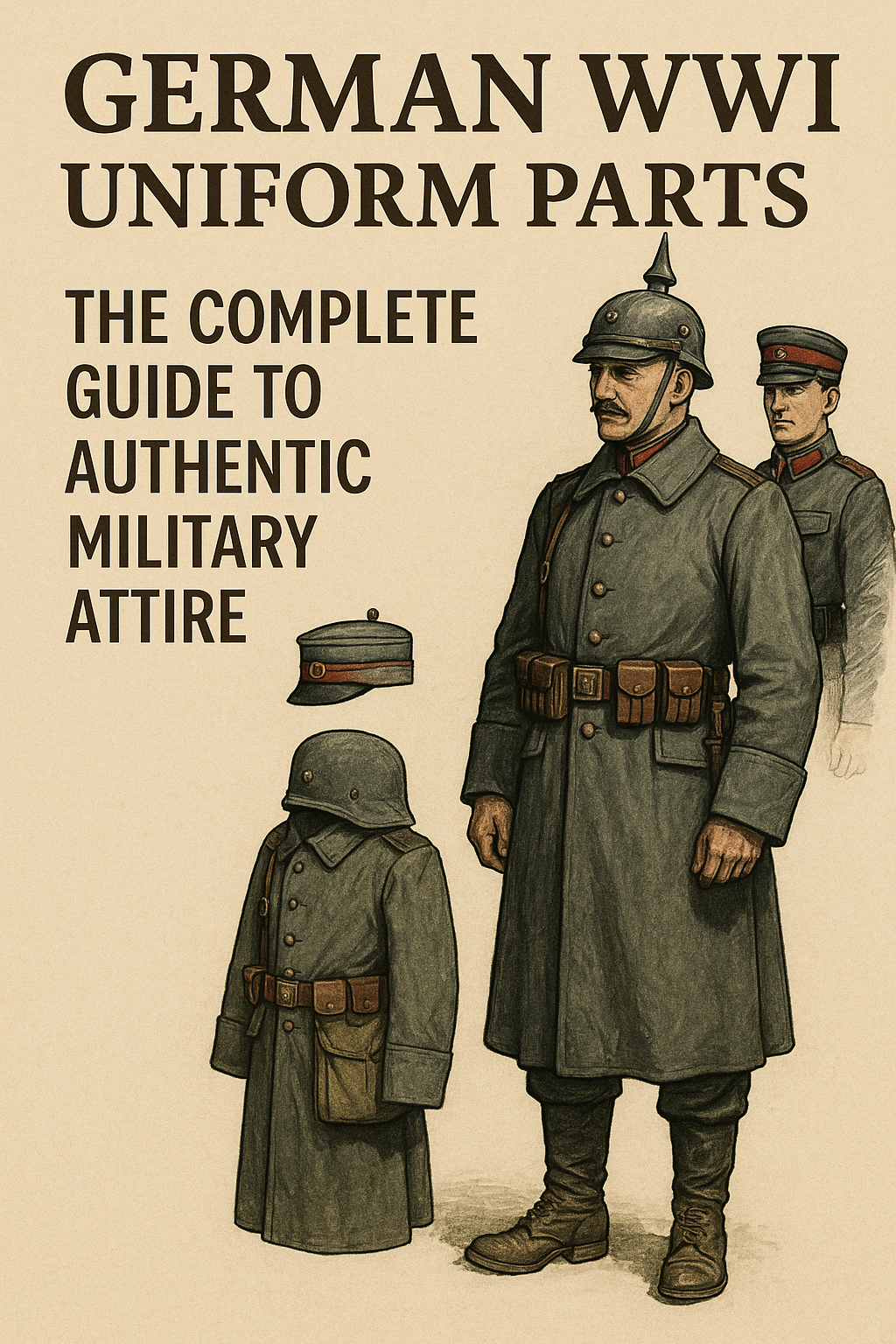
German WWI Uniform Parts: The Complete Guide to Authentic Military Attire
Published on May 22, 2025
German WWI Uniform Parts: The Complete Guide to Authentic Military Attire
World War I marked a significant turning point in the evolution of military uniforms. Germany, one of the key players in the war, developed a distinct and highly functional military outfit that remains a symbol of wartime resilience and adaptation. From the iconic field-grey greatcoats to steel helmets that replaced outdated spiked headgear, every part of the German WWI uniform was designed with purpose and practicality in mind.
If you're a military history buff, collector, or reenactor, understanding the components of the German WWI uniform is essential. This guide will walk you through the most iconic uniform parts worn by German soldiers during the First World War.
1. The WW1 German Greatcoat (Mantel): Warmth in the Trenches
The WW1 German greatcoat, known as the "Mantel," was one of the most critical pieces of military gear, especially during harsh European winters.
Key Features:
- Material: Thick, heavy wool provided excellent insulation.
- Color: Typically field grey (Feldgrau), which became the standard color to better camouflage soldiers.
- Design: Double-breasted with large lapels and turn-back cuffs. Some featured shoulder straps and adjustable belts for a snug fit.
These greatcoats weren’t just for show — they were multifunctional. Soldiers used them as blankets, bedrolls, and makeshift pillows in the trenches. The greatcoat also displayed a soldier's rank or regiment via insignia and colored piping, making it both functional and symbolic.
2. WW1 German Field Caps and Hats: Markers of Rank and Region
The headgear worn by German troops evolved throughout the war, shifting from the traditional soft cap to sturdier helmets as trench warfare intensified.
Popular Headgear Types:
- M1907 Field Cap: Soft cap with red piping and cockades representing the German Empire and state.
- M1910/1915 Field Caps: Later models had subdued tones and were simplified to speed up mass production.
- Pickelhaube (Spiked Helmet): Early war helmet made of leather, later phased out due to its poor protection.
- Stahlhelm (Steel Helmet): Introduced in 1916, it dramatically improved head protection from shrapnel and bullets.
The German WW1 cap remains a favorite among collectors due to its symbolic representation of imperial pride and military heritage.
3. Trousers and Tunics: Built for Endurance
The trousers and tunics of the German uniform had to withstand rough conditions. Soldiers marched long distances, dug trenches, and endured extreme weather. As such, durability and functionality were top priorities.
Tunic (Bluse) Highlights:
- Single-breasted with a standing collar.
- Epaulettes and colored piping indicated unit and rank.
- Later versions simplified to reduce manufacturing costs.
Trousers:
- Constructed from wool with reinforced knees.
- Straight-cut for mobility.
- Often paired with suspenders or belts for support.
Both tunics and trousers were designed to blend in with the environment and allow unrestricted movement during combat.
4. German Winter Coat: Survival in Harsh Conditions
The German winter coat was essential for soldiers stationed on the Eastern and Western fronts where temperatures dropped well below freezing. These coats were often lined with fur or heavy padding for insulation.
Design Elements:
- Long cut to cover most of the body.
- High collars and internal lining for warmth.
- Often worn over a tunic and paired with scarves or balaclavas.
This outerwear could be seen in later uniforms, influencing designs like the WW2 German parka, but its roots stem from the challenges faced during WWI.
5. Footwear: The Marching Foundation
Proper footwear was vital for survival and performance. In WWI, the German army issued durable boots designed for long-distance marches and trench conditions.
Boot Styles:
- Jackboots (Marschstiefel): Knee-high leather boots, tough and protective.
- Ankle Boots with Gaiters: Introduced later in the war to conserve materials and improve mobility.
Though not WWI-specific, the German WW2 combat boots were influenced by the practical designs of WWI, showing a legacy of evolution in German military footwear.
6. Accessories: Functional and Tactical
Beyond the main garments, German soldiers carried several accessories that completed their uniforms and served tactical purposes.
Common Accessories:
- Belt with Buckle: Held pouches, bayonets, and other essentials.
- Entrenching Tool: Compact shovels for digging trenches.
- Bread Bag and Canteen: Carried food and water.
- Gas Mask Canister: Introduced later due to the rising threat of chemical warfare.
These additions weren’t just military gear — they were survival tools. Soldiers depended on them daily in the unforgiving conditions of trench warfare.
Why Collect German WWI Uniform Parts?
There’s something profoundly compelling about owning a piece of history. Whether you're a reenactor aiming for accuracy or a collector with a passion for military heritage, German WWI uniform parts offer a tangible link to the past.
Benefits for Collectors & Reenactors:
- Historical Accuracy: Get the details right for living history events.
- Investment Value: Authentic reproductions and well-preserved originals can appreciate over time.
- Educational Use: Museums and educators often use these items to teach WWI history.
Authenticity matters. Paying attention to the cut, color, materials, and insignia ensures your uniform reflects the era accurately.
Final Thoughts
The German WWI uniform was a masterpiece of function and design, reflecting the intense realities of trench warfare and the industrial era's demands. Each component — from the winter greatcoat to the field cap — tells a story of innovation, survival, and identity.
Whether you're building a full uniform for reenactment or curating a private collection, understanding each uniform part's role helps you appreciate the history they represent. And with high-quality reproductions now more accessible than ever, honoring the past has never been more achievable.
